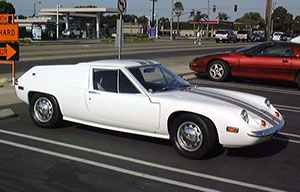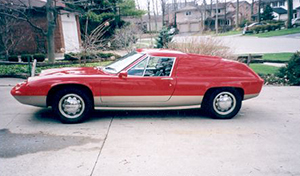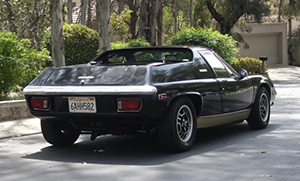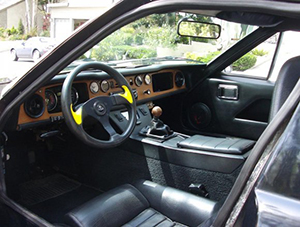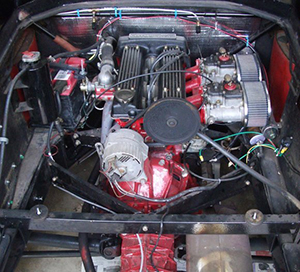1966-75 Lotus Europa
A mid-engine layout was used
for world-class race cars and exotic road cars in the 1960s. That made
England’s Lotus—known mostly for its winning race
cars—the first automaker to build a mid-engine road car for
the masses with its 1966-75 Europa sports car.
The small, light Europa stood about as high as a child. As with all
mid-engine cars, the affordable Europa’s engine was tucked
between the passenger compartment and rear wheels for the best balance
and handling.
Lotus race cars had world-wide fame by the mid-1960s, partly because a
mid-engine Lotus ran away with the Indianapolis 500 in 1965 and largely
caused Indy 500 race car builders to abandon their traditional
front-engine layout in favor of a mid-engine one.
Lotus founder and owner Colin Chapman was an auto design genius who
began building small race cars in the early 1950s. He was pretty much
the first to apply extremely lightweight aircraft construction to road
and race cars.
Chapman’s first serious road car—the small
front-engine 1957-63 Elite weighed only 1,455 pounds. His second was
the small front-engine Elan, introduced in 1962. The Elan lasted
through 1973 and was copied by Mazda when that Japanese automaker
designed its wildly popular Miata sports car, which arrived for 1990.
Despite its fame and international race car championships, Lotus used
engines from major automakers—mostly Ford—with
Lotus-designed power-enhancing cylinder heads because it was a small
outfit that couldn’t afford to develop complete motors.
The two-seat Europa looked like a regular sports car from its front to
the end of its doors. But it then had high “sail
panels” that flanked a flat, detachable engine cover below a
slitlike rear window.
Beautiful, it wasn’t. But never mind. Under the cover was a
modified 1.5-liter four-cylinder engine from the new French Renault 16
sedan. The alloy engine only produced 78 horsepower, but the fiberglass
body Europa merely weighed 1,350 pounds. Performance thus was lively
with a Renault four-speed manual transmission.
The lightweight construction also resulted in high fuel economy, and
the mid-engine location and excellent suspension resulted in
exceptional steering and handling.
The body was bonded (glued) to Lotus’s traditional steel
one-piece backbone chassis to hold down performance-robbing weight. And
an all-independent coil-spring suspension provided a good ride, besides
the car’s superb roadability.
Chapman had been thinking about making an inexpensive mid-engine road
car for some time, but couldn’t find an affordable
engine-transmission combo for such a car until the Renault 16 arrived.
Sales of the Europa Series 1 model were limited to the Continent,
outside England, for a few years because Chapman wanted to establish a
presence in the new European Common Market. That’s partly why
the auto used Renault components. Chapman diplomatically suggested that
the car be named “Europe,” although the name soon
was changed to “Europa.”
The first Europas were offered in factory built or kit car form to
escape stiff taxes for assembled factory cars in Europe.
Although largely hand-built, the Europa was like other Lotus road cars
in that its assembly quality was average, at best. It had a cramped
interior and fixed door windows, instead of roll-down ones to save
weight.
The Series 2 Europa, which solved some of the problems, was announced
in 1968 and made available for America. The body now was bolted to the
chassis to make accident repairs easier, and power windows were added.
There also was more space around the pedals and added luggage room
behind the Renault engine, which was slightly increased in size to
develop 88 horsepower. The larger engine helped counter new
power-robbing U.S. emission standards.
British Europa sales began in mid-1969, when Chapman hired top engineer
Mike Kimberley from Jaguar, who was told to develop a less quirky, even
more powerful Europa. The result was the late 1971 Europa Series 3
Twin-Cam, with a dual-overhead-camshaft 1.6-liter, 105-horsepower Ford
four cylinder modified with Lotus cylinder heads.
The Renault transmission was retained, but styling and driver
vision was improved by cutting down the body sail
panels—although the engine remained beneath the flat rear
cover. Attractive new cast-alloy wheels also were put on the car. It
now could hit 120 mph.—up from 110 mph.
It was easy for American car buffs to fall in love with the Europa.
Lotus had a fabulous racing reputation, and the Europa’s
fairly low price (initially $4,695) allowed average folks to buy the
car, with its competition-inspired mid-engine design and race-car-style
handling.
Things improved even more when Lotus introduced the Europa Twin Cam
Special in late 1972 with a 126 horsepower “Big
Valve” version of the engine. A new Renault five-speed manual
transmission was initially optional, but was made standard for 1974.
Acceleration was much stronger. Acceleration was quicker, and top speed
rose to 125-plus mph.
Most Europas sold in America were the more-desirable Series 3 Twin-Cam
and Twin-Cam Special models, discontinued here after 1974 because of
stringent federal regulations.
Europa production ended in 1975 after about 9,200 units were built. The
car was replaced by the radical, slinky looking mid-engine Lotus
Esprit, which made many soon forget the Europa.
But Europas are flat-out bargains—if you can find a good one.
A specially painted and trimmed 1973 “John Player
Special“ model is especially desirable.
A new generation of Lotus road cars arrived a few years ago, and
they’re a blast to drive—just like the Europa.

